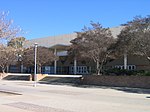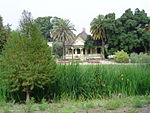East Coyote Hills
Geography of Fullerton, CaliforniaHills of CaliforniaMountain ranges of Orange County, CaliforniaMountain ranges of Southern CaliforniaOrange County, California geography stubs ... and 2 more
Peninsular RangesPlacentia, California
The East Coyote Hills are a low mountain range in northern Orange County, California, mostly in the cities of Fullerton and Placentia.The hills received their name from the nearby Rancho Los Coyotes; by the 1870s they were being called Coyote Hills. Most of the East Coyote Hills were developed as residential areas in the 1980s and 1990s. Several equestrian and pedestrian trails have been built through the area, as well as a golf course and Craig Regional Park.
Excerpt from the Wikipedia article East Coyote Hills (License: CC BY-SA 3.0, Authors).East Coyote Hills
North Acacia Avenue, Fullerton
Geographical coordinates (GPS) Address Nearby Places Show on map
Geographical coordinates (GPS)
| Latitude | Longitude |
|---|---|
| N 33.892236388889 ° | E -117.90200444444 ° |
Address
North Acacia Avenue
92831 Fullerton
California, United States
Open on Google Maps




